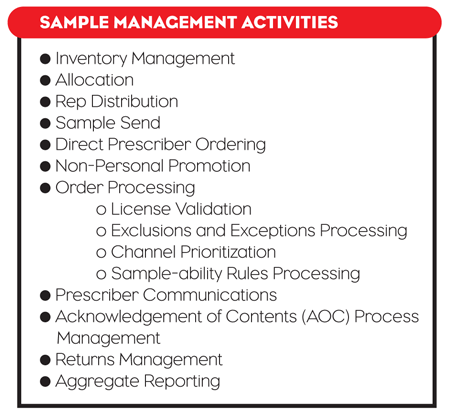To put Multichannel 2.0 into context, one needs to look beyond the familiar nearby landscape of multi-channel “marketing,” to the far more encompassing horizon where samples are distributed to prescribers. This is a far broader geography that includes a vast array of activities, all of which contribute to the opportunities and “decisions” for sampling. Marketing is certainly an important component, but so are validation, exclusions, exceptions, and other regulatory processes. There are also channel prioritization, communication, and distribution decisions.
Managing these highly dependent processes is a demanding specialty, particularly in this highly competitive and economically challenging environment. So many pharma companies are re-evaluating their internal efforts based on core competencies and looking towards outsourcing for closed-loop technology solutions that provide broad visibility and cost efficiencies to feed their internal decision making engines. Enter Multichannel 2.0—complex systems that manage and report on this vast array of processes and data, freeing pharmaceutical companies to focus their efforts on reaching required demand goals with reduced budgets.
EVOLUTION
The evolution toward Multichannel 2.0 starts with the economics of today’s pharmaceutical environment. A rapid decline in development of blockbusters while patents expire on those few remaining, coupled with increased challenges in FDA approvals and rising regulatory pressures, creates a renewed emphasis on cutting cost and increasing productivity. The result is often a forced introspection of sorts, with Pharma looking inward and making hard but necessary decisions based on rigid cost benefit analysis.
Many pharma companies have already begun fundamental reorganizations as part of their comprehensive strategy to remain competitive. Many of those strategies include redevelopment of “processes” as well as structure with re-consideration towards outsourcing.
Sample management offers one extraordinary opportunity for such process reform. Sample management embraces many distinct activities (see table). Closed-loop management of these activities can produce extraordinary efficiencies standardizing data, request processing, business rules application, and process dependencies. These systems increase visibility across all verticals while cutting waste through predetermined logic applied throughout the process. Such systems also provide a much more holistic approach toward prescriber relationship management, with all activities monitored and measured at the prescriber level. The relationships become stronger as experience within the system grows, and greater response data becomes available for critical analysis and subsequent process adjustments.
SYNCHRONIZATION
Tearing down the walls between independent processes and reassembling them as collaborative, synchronized systems can produce extraordinary savings. The newly achieved visibility reveals such issues as conflicting messages, duplication of effort, over (or under) sampling, regulatory roadblocks, and misaligned business rules across verticals.
Waste is the enemy of efficiency, and waste can best be identified through transparency. The newly emerging closed-loop solutions of Multichannel 2.0 are the quintessential waste-removal tools. As these systems are developed and adopted (internally, or through strategic partnerships with competent service providers), scalability and flexibility help double efficiency by reducing internal as well as potential external (service provider) effort and relative cost.
As the industry has evolved to keep pace with new marketing options, regulatory governance, and economic pressures, their processes have become more complex and disparate. Darwinian competition has forced corporations to optimize structures. Process optimization is the next frontier. To create lean processes that maintain synergy across verticals and provide efficient and adherent results, consolidation (and arguably outsourcing) becomes critical. Multichannel 2.0 is the response to this need. And it is on the path to become the industry’s process-based efficiency engine. In our next installment, we will dive deeper into the solution and discuss some of the individual components and their extraordinary value within the aggregated processes.

Next time: more detail on individual components and their value to the aggregated processes.
Email your question to Richard Meyer, our DTC expert, for the answer.



